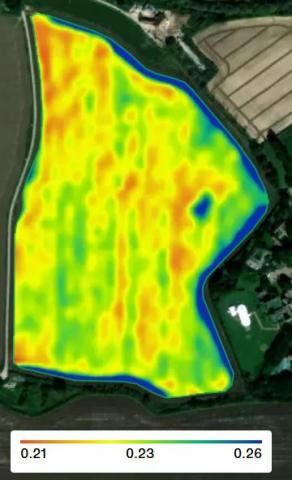Results summary: Close to harvest, NDVI was higher in the Utrisha N treated tramline and stems were visibly greener, but this was not followed by any measurable yield benefit. It is possible that Utrisha N could have contributed to a longer grain filling period and higher yield, had harvest been delayed to accommodate this. The potential for Utrisha N to improve yield may also have been limited by the early harvest caused by hot, dry weather in July 2022, and by the lower than usual N optima seen in 2022; given that Utrisha N is supposed to supply additional N to plants via N fixation, we would only expect a significant yield benefit in situations where yield is limited by N supply.

As part of the AICC Crop Nutrition Club 2022, this on-farm winter oats trial tested the effects of applying Utrisha N. The trial was facilitated by a local AICC advisor, with support and Agronomics yield map analysis from ADAS.
Recommended Content
Connected Content
ADAS provides ideas, specialist knowledge and solutions to secure our food and enhance the environment. We understand food production and the challenges and opportunities faced by organisations operating in the natural environment
Biostimulants are increasingly available and are now widely marketed to farmers. While the jury is still out on a definitive definition, most definitions of biostimulants explain that they should stimulate plant nutrition processes independently of the product’s nutrient content with the aim of improving one or more of the following characteristics: nutrient efficiency, tolerance to abiotic stress, and/or quality.
Supporting farmers with robust design and analysis of on-farm experiments in tramline trials.
Farm-centric research generally involves On-Farm Experimentation and may be better described as 'Farm Action Research', i.e. research conducted at least in part by and for beneficiaries who also farm.
On Farm Experimentation (OFE) is increasingly being recognised as having transformative power in improving performance in agricultural systems across the world.
AICC member agronomists are now the preferred source of advice on over 2.2 million hectares, which is almost half of the UK’s arable land, and the demand for it is stronger than ever
Farmers, advisors and researchers working together to understand and improve crop nutrition on-farm
Some symbiotic or free-living microorganisms can fix inert di-nitrogen (N) from the air into reactive organic nitrogenous compounds. Most biological N fixation (BNF) in farming systems occurs in the root nodules of legumes where rhizobium bacteria take photosynthates from the plant in exchange for fixing atmospheric N and returning ammonium or amides which the plant uses to form amino acids, proteins, etc. Plants need more N than any other nutrient and N commonly limits plant growth in many ecosystems.
A range of products are commercially available that claim to enable more efficient nutrient uptake, allowing less nutrient to be applied as fertiliser.
AICC Advisors and farmers testing appropriate nitrogen rates and strategies for reduction in light of current high prices. Brought together by the FarmPEP FIP project



